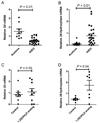Vitamin D3 inhibits hedgehog signaling and proliferation in murine Basal cell carcinomas
- PMID: 21436386
- PMCID: PMC3088781
- DOI: 10.1158/1940-6207.CAPR-10-0285
Vitamin D3 inhibits hedgehog signaling and proliferation in murine Basal cell carcinomas
Abstract
Constitutive Hedgehog (HH) signaling underlies several human tumors, including basal cell carcinoma (BCC). Recently, Bijlsma and colleagues reported a new biologic function for vitamin D3 in suppressing HH signaling in an in vitro model system. On the basis of that work, we have assessed effects of vitamin D3 on HH signaling and proliferation of murine BCCs in vitro and in vivo. We find that indeed in BCC cells, vitamin D3 blocks both proliferation and HH signaling as assessed by mRNA expression of the HH target gene Gli1. These effects of vitamin D3 on Gli1 expression and on BCC cell proliferation are comparable to the effects of cyclopamine, a known inhibitor of the HH pathway. These results are specific for vitamin D3, because the precursor 7-dehydrocholesterol and the downstream products 25-hydroxy vitamin D3 [25(OH)D] and 1,25-dihydroxy vitamin D3 [1,25(OH)(2)D] are considerably less effective in reducing either Gli1 mRNA or cellular proliferation. Moreover, these effects seem to be independent of the vitamin D receptor (VDR) because short hairpin RNA knockdown of VDR does not abrogate the anti-HH effects of D3 despite reducing expression of the VDR target gene 24-hydroxylase. Finally, topical vitamin D3 treatment of existing murine BCC tumors significantly decreases Gli1 and Ki67 staining. Thus, topical vitamin D3 acting via its HH inhibiting effect may hold promise as an effective anti-BCC agent.
Conflict of interest statement
The authors state no conflict of interest
Figures




Similar articles
-
Antitumoral effects of calcitriol in basal cell carcinomas involve inhibition of hedgehog signaling and induction of vitamin D receptor signaling and differentiation.Mol Cancer Ther. 2011 Nov;10(11):2179-88. doi: 10.1158/1535-7163.MCT-11-0422. Epub 2011 Aug 30. Mol Cancer Ther. 2011. PMID: 21878656
-
Pituitary adenylyl cyclase activating polypeptide inhibits gli1 gene expression and proliferation in primary medulloblastoma derived tumorsphere cultures.BMC Cancer. 2010 Dec 9;10:676. doi: 10.1186/1471-2407-10-676. BMC Cancer. 2010. PMID: 21143927 Free PMC article.
-
Synergism between Hedgehog-GLI and EGFR signaling in Hedgehog-responsive human medulloblastoma cells induces downregulation of canonical Hedgehog-target genes and stabilized expression of GLI1.PLoS One. 2013 Jun 10;8(6):e65403. doi: 10.1371/journal.pone.0065403. Print 2013. PLoS One. 2013. PMID: 23762360 Free PMC article.
-
Interaction of hedgehog and vitamin D signaling pathways in basal cell carcinomas.Adv Exp Med Biol. 2014;810:329-41. doi: 10.1007/978-1-4939-0437-2_18. Adv Exp Med Biol. 2014. PMID: 25207374 Review.
-
Cross-Talk between Wnt and Hh Signaling Pathways in the Pathology of Basal Cell Carcinoma.Int J Environ Res Public Health. 2018 Jul 9;15(7):1442. doi: 10.3390/ijerph15071442. Int J Environ Res Public Health. 2018. PMID: 29987229 Free PMC article. Review.
Cited by
-
Protective role of vitamin D signaling in skin cancer formation.J Steroid Biochem Mol Biol. 2013 Jul;136:271-9. doi: 10.1016/j.jsbmb.2012.09.021. Epub 2012 Oct 8. J Steroid Biochem Mol Biol. 2013. PMID: 23059470 Free PMC article. Review.
-
Vitamin D3 suppresses the cholesterol homeostasis pathway in patient-derived glioma cell lines.FEBS Open Bio. 2023 Sep;13(9):1789-1806. doi: 10.1002/2211-5463.13679. Epub 2023 Jul 31. FEBS Open Bio. 2023. PMID: 37489660 Free PMC article.
-
Photoprotective Properties of Vitamin D and Lumisterol Hydroxyderivatives.Cell Biochem Biophys. 2020 Jun;78(2):165-180. doi: 10.1007/s12013-020-00913-6. Epub 2020 May 22. Cell Biochem Biophys. 2020. PMID: 32441029 Free PMC article. Review.
-
Dermal adipocytes and hair cycling: is spatial heterogeneity a characteristic feature of the dermal adipose tissue depot?Exp Dermatol. 2016 Apr;25(4):258-62. doi: 10.1111/exd.12941. Epub 2016 Feb 26. Exp Dermatol. 2016. PMID: 26781768 Free PMC article.
-
The Role of Classical and Novel Forms of Vitamin D in the Pathogenesis and Progression of Nonmelanoma Skin Cancers.Adv Exp Med Biol. 2020;1268:257-283. doi: 10.1007/978-3-030-46227-7_13. Adv Exp Med Biol. 2020. PMID: 32918223 Free PMC article. Review.
References
-
- Apperly F. The relation of solar radiation to cancer mortality in North America. Cancer Res. 1941;1:191–195. - PubMed
-
- Garland F, Garland C, Gorham E, Young J. Geographic variation in breast cancer mortality in the United States: a hypothesis involving exposure to solar radiation. Prev Med. 1990;19:614–622. - PubMed
-
- Wactawski-Wende J, Kotchen JM, Anderson GL, et al. Calcium plus vitamin D supplementation and the risk of colorectal cancer. N Engl J Med. 2006;354:684–696. - PubMed
-
- Lappe JM, Travers-Gustafson D, Davies KM, Recker RR, Heaney RP. Vitamin D and calcium supplementation reduces cancer risk: results of a randomized trial. Am J Clin Nutr. 2007;85:1586–1591. - PubMed
Publication types
MeSH terms
Substances
Grants and funding
LinkOut - more resources
Full Text Sources
Other Literature Sources
Molecular Biology Databases

